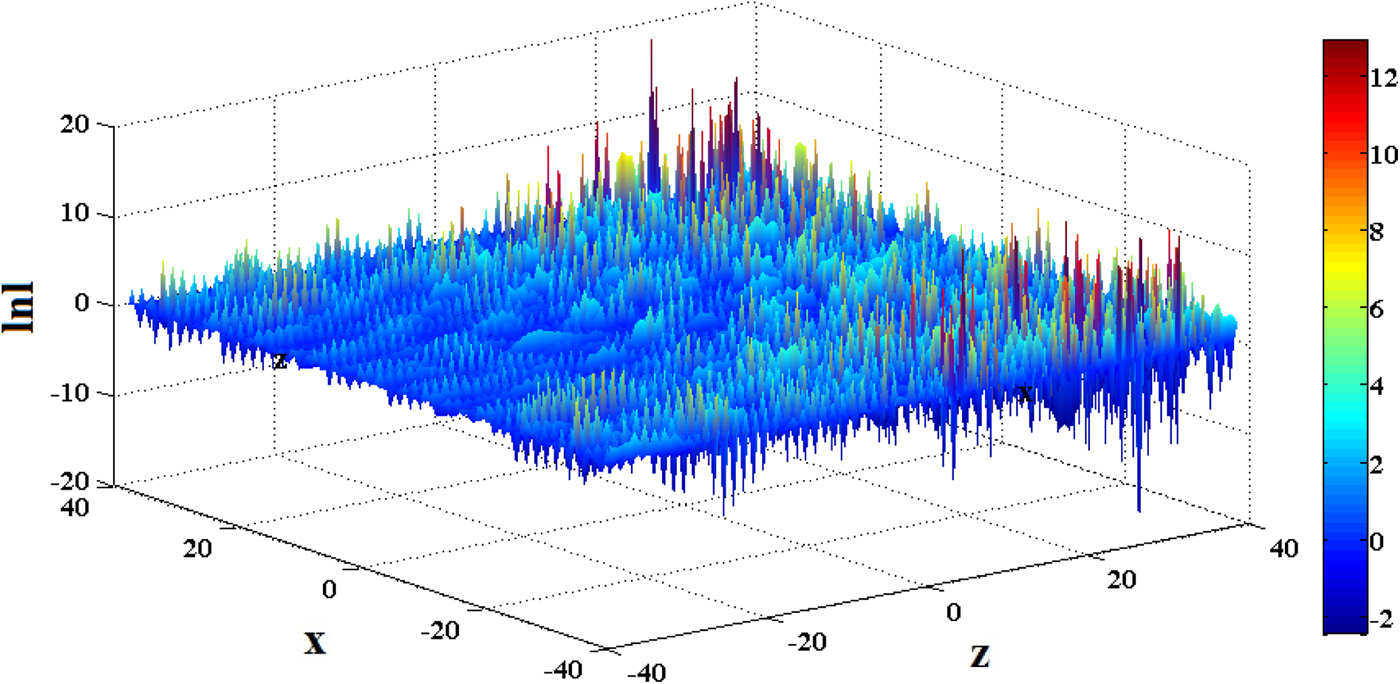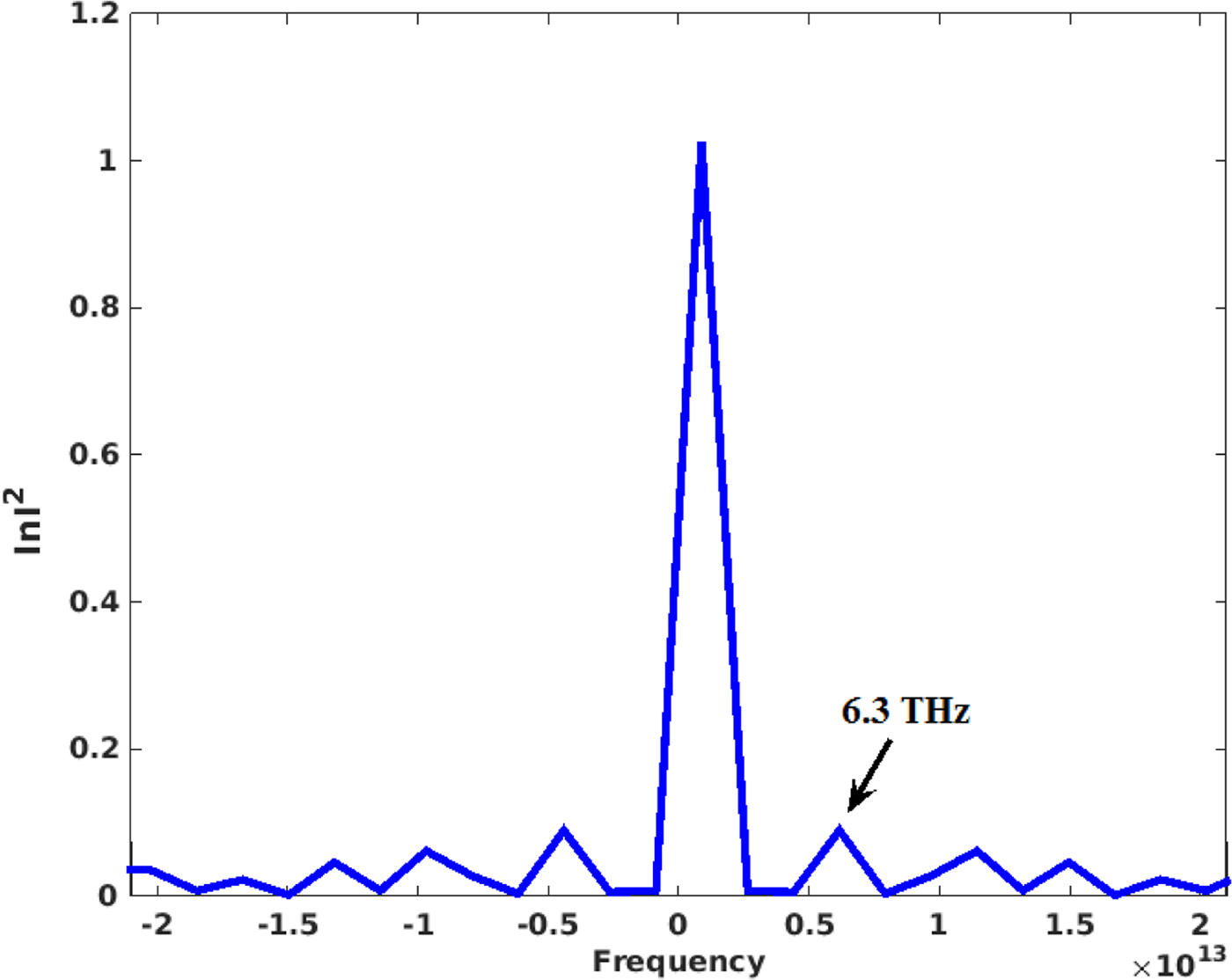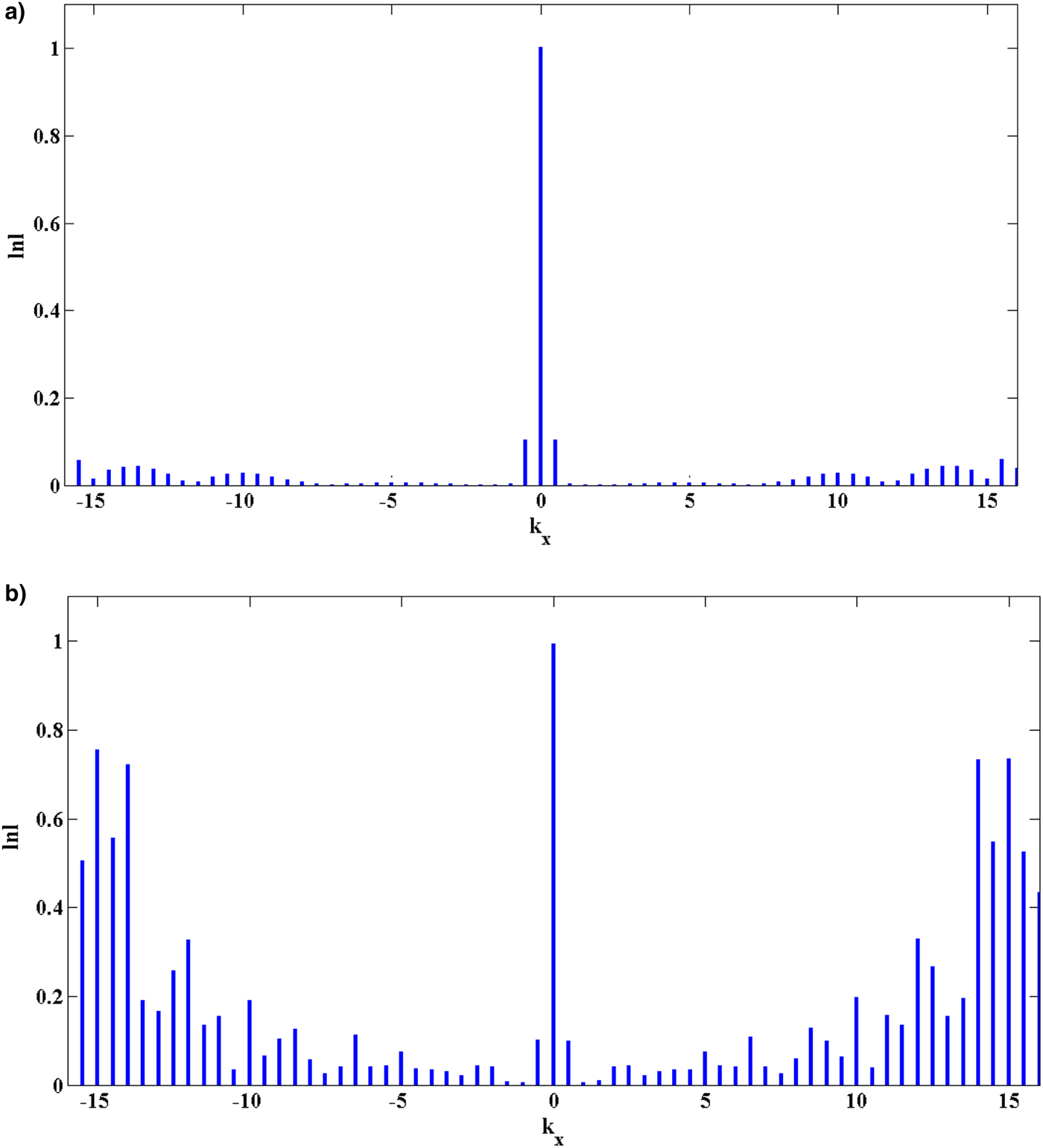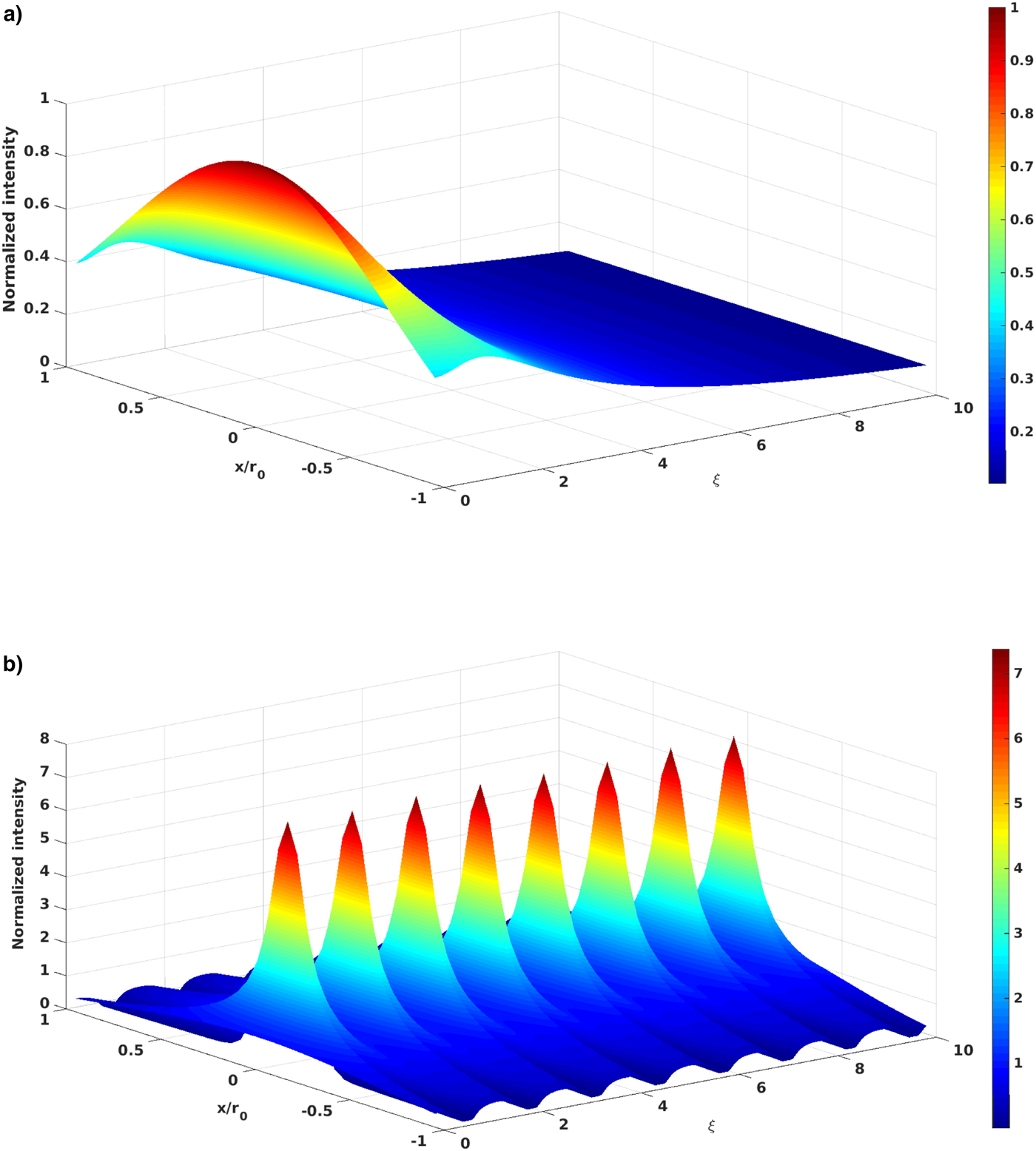Introduction
The study of non-linear interaction of high-power laser with plasma is an area of very much importance. For laser–plasma-based applications, one needs an understanding of laser pulse energy absorption and its coupling with plasma species or electrostatic modes of plasmas (Chen and Sudan, Reference Chen and Sudan1993; Adak et al., Reference Adak, Blackman, Chatterjee, Singh, Lad, Brijesh, Robinson, Pasley and Kumar2014; Sharma et al., Reference Sharma, Kumar, Hussain and Sharma2017). The laser imparts large quiver velocity to electrons that non-linearly couples with the collective modes of the plasma, giving rise to an ample of non-linear processes such as decay and modulational instability, stimulated Raman and Brillouin scattering, resonant absorption, self-focusing and filamentation of the laser pump (Ozaki et al., Reference Ozaki, Elouga, Ganeev, Kieffer, Suzuki and Kuroda2007; Mulser and Bauer, Reference Malka, Modena, Nazmudin, Danger, Clayton, Marsh, Joshi, Danson, Neely and Walsh2010). Parametric instabilities have proven to be detrimental to the success of laser-induced fusion (Kaw et al., Reference Kaw, Schmidt and Wilcox1973; Kruer, Reference Kruer1974; Liu and Tripathi, Reference Liu and Tripathi1986; Umstadter, Reference Umstadter2003).
Malka et al. (Reference Malka, Modena, Nazmudin, Danger, Clayton, Marsh, Joshi, Danson, Neely and Walsh1997) and Modena et al. (Reference Modena, Najmudin, Clayton, Marsh, Joshi, Malka, Darrow, Danson, Neely and Walsh1995) have studied the electron plasma wave for high-energy electron acceleration and have shown that the electron plasma wave-associated electric field can be very large in short distances. The transient evolutions of laser pump in plasma have been studied under ponderomotive non-linearity by Sharma et al. (Reference Sharma, Hussain and Gaur2015). They have numerically solved the coupled system of equations comprising laser beam and ion acoustic wave (modified Zakharov system of equations). The ion acoustic spectra contain spatial harmonics which get modified with time and result in the laser beam localization.
Sprangle et al. (Reference Sprangle, Esarey and Ting1990) have derived coupled non-linear equations for the vector potential of the radiation field and the electrostatic potential of the plasma by using the cold-fluid model along with “quasistatic” approximation. This approximate one-dimensional non-linear model describes the self-consistent interaction of intense laser pulse and plasma. Pukhov and Meyer-ter-Vehn (Reference Pukhov and Meyer-ter-Vehn2002) have carried out 3D particle-in-cell simulations of the short laser pulse at relativistic intensity for the propagation in slightly under-dense plasma. Their work showed the occurrence of the mono-energetic beam of electron bunches (~300 MeV) from the 3D wave breaking of the laser wake field. Feit et al. (Reference Feit, Komashko and Rubenchik2001) have also studied the intense beam self-focusing in under-dense plasma and show that a laser beam can be self-channeled in plasma if laser intensity is high enough to produce electron cavitation.
Brandi et al. (Reference Brandi, Manus and Mainfray1993) analyzed the self-focusing of the laser beam under quasi steady-state approximation and also derived the equations for laser beam and plasma oscillation dynamics under relativistic ponderomotive non-linearity. The present study analyzes the transient relativistic ponderomotive non-linearity when the quasi steady approximation is not taken into account using the computational method to solve the coupled equation of laser pump and electron plasma oscillations. The generation of density harmonics and their effects on the filamentation of laser beam have also been investigated. In addition to the computation method, a semi-analytic model has also been presented to describe the non-linear development of the laser beam.
The present study is very important as the transient evolution of electron density variation involves applications including harmonic generation of plasma oscillations in THz frequency range and filamentation of the laser beam. This study is done at a very high laser frequency compared to the electron plasma frequency for under-dense plasma. The transient evolution of electron density variation is of considerable interest and has given rise to applications including harmonic generation of plasma oscillations in THz frequency range and filamentation of the laser beam.
This paper is organized as follows: section “Model equations for laser and plasma oscillations” discussed the coupled equations of laser and plasma oscillations in the plasma when the coupling arises via relativistic ponderomotive non-linearity. Section “Numerical simulation and results” presented the numerical simulation results, section “Transient self-focusing: a semi-analytical approach” presented transient self-focusing from the semi-analytical model, and section “Conclusion” consists of conclusion.
Model equations for laser and plasma oscillations
The propagation dynamics of the laser beam and plasma oscillations in a collisionless plasma coupled through ponderomotive and relativistic non-linearity have been obtained as follows.
Equation for the laser
The propagation of a linearly polarized intense laser pump of frequency ω0 along z-direction in an under-dense plasma, of equilibrium electron density, n 0 has been considered.
The laser is considered to be propagating in a medium with plasma density oscillations in the background. The laser beam dynamical equation can be obtained (Ginzburg, Reference Ginzburg1970) from the equations of continuity and momentum balance and also with the Maxwell's equations:
 $$\displaystyle{{\partial \lpar {m_j{\vec{v}}_j} \rpar } \over {\partial t}} + \vec{v}_j.\nabla \lpar {m_j{\vec{v}}_j} \rpar = \,\;q_j\left\{ {\vec{E} + \displaystyle{{({\vec{v}}_j \times \vec{B})} \over c}} \right\}$$
$$\displaystyle{{\partial \lpar {m_j{\vec{v}}_j} \rpar } \over {\partial t}} + \vec{v}_j.\nabla \lpar {m_j{\vec{v}}_j} \rpar = \,\;q_j\left\{ {\vec{E} + \displaystyle{{({\vec{v}}_j \times \vec{B})} \over c}} \right\}$$where, j symbolizes plasma species (e for electron and i for ion) and q j, m j, v j, n j and T j symbolize the charge, mass, velocity, number density, and energy of the plasma species, respectively. The wave equation in the x-component of the electric field can be obtained by combining Eqs. (3) and (4)
For ![]() $\nabla {\rm \varepsilon} /{\rm \varepsilon} \;\ll 1$, one may ignore
$\nabla {\rm \varepsilon} /{\rm \varepsilon} \;\ll 1$, one may ignore ![]() $\lpar {\nabla \lpar {\nabla. \vec{E}} \rpar } \rpar _x$ term in the wave equation (Sodha et al., Reference Sodha, Ghatak and Tripathi1976), where ε is the non-linear plasma dielectric constant.
$\lpar {\nabla \lpar {\nabla. \vec{E}} \rpar } \rpar _x$ term in the wave equation (Sodha et al., Reference Sodha, Ghatak and Tripathi1976), where ε is the non-linear plasma dielectric constant.
The solution of Eq. (5) can be written as follows (Sodha et al., Reference Sodha, Ghatak and Tripathi1976):
where A(x, z, t) is the wave amplitude of slow space and time dependence,
 $$k_0 = \displaystyle{{{\rm \omega} _0} \over c}\left[ {1-\displaystyle{{{\rm \omega}_{{\rm p}0}^2} \over {{\rm \gamma} {\rm \omega}_0^2}}} \right]^{1/2}$$
$$k_0 = \displaystyle{{{\rm \omega} _0} \over c}\left[ {1-\displaystyle{{{\rm \omega}_{{\rm p}0}^2} \over {{\rm \gamma} {\rm \omega}_0^2}}} \right]^{1/2}$$and ![]() ${\rm \omega} _{{\rm p}0}^2 = 4{\rm \pi} n_0e^2/m_{{\rm e}0}$, m e0 is the electron rest mass and γ{ = (1 + a 2/2)1/2} is the relativistic factor and
${\rm \omega} _{{\rm p}0}^2 = 4{\rm \pi} n_0e^2/m_{{\rm e}0}$, m e0 is the electron rest mass and γ{ = (1 + a 2/2)1/2} is the relativistic factor and
By using the relation, J x = −en ev e, where n e = n o + n 1; ![]() $\vec{v}_{\rm e}\lpar { = e\vec{E}/m_{\rm e}i{\rm \omega}_0} \rpar $ is the drift velocity of electrons and we obtain
$\vec{v}_{\rm e}\lpar { = e\vec{E}/m_{\rm e}i{\rm \omega}_0} \rpar $ is the drift velocity of electrons and we obtain
Using Eqs. (6) and (7) in Eq. (5), we derive in the WKB approximation (Akhmanov et al., Reference Akhmanov, Sukhorukov and Khokhlov1968).
Dynamics of plasma oscillation
A laser with non-uniform amplitude (e.g., Periodic) along its wavefront exerts a relativistic ponderomotive force (![]() $\overrightarrow F _{\rm p}\lcub { = -m_{{\rm e}0}c^2\nabla \lpar {{\rm \gamma} -1} \rpar } \rcub $) on electrons and electrons move away under the influence of this force, from the maximum field amplitude region (Brandi et al., Reference Brandi, Manus and Mainfray1993). For the case, when the pulse duration is shorter than ion plasma period, the ions do not have enough time to move, which creates charge imbalance between ions and electrons which results in a space charge field (
$\overrightarrow F _{\rm p}\lcub { = -m_{{\rm e}0}c^2\nabla \lpar {{\rm \gamma} -1} \rpar } \rcub $) on electrons and electrons move away under the influence of this force, from the maximum field amplitude region (Brandi et al., Reference Brandi, Manus and Mainfray1993). For the case, when the pulse duration is shorter than ion plasma period, the ions do not have enough time to move, which creates charge imbalance between ions and electrons which results in a space charge field (![]() $\vec{E}_{\rm p}$). Taking the time derivative of the continuity equation [Eq. (1)] and using the equation of motion of the electron [Eq. (2)], we get the following equation of electron density
$\vec{E}_{\rm p}$). Taking the time derivative of the continuity equation [Eq. (1)] and using the equation of motion of the electron [Eq. (2)], we get the following equation of electron density
 $$\eqalign{\displaystyle{{\partial ^2n_{\rm e}} \over {\partial t^2}}-\displaystyle{{e\nabla. \lpar {n_{\rm e}\vec{E}} \rpar } \over {m_{{\rm e}0}{\rm \gamma}}} & = \nabla. \left\{ {\displaystyle{{{\vec{v}}_{\rm e}.\nabla \lpar {{\rm \gamma} {\vec{v}}_{\rm e}} \rpar } \over {\rm \gamma}} + \displaystyle{{e{\vec{v}}_{\rm e} \times \vec{B}} \over {m_{{\rm e}0}{\rm \gamma} c}}} \right\}n_{\rm e} \cr & -\nabla. \left\{ {-\displaystyle{{n_{\rm e}} \over {\rm \gamma}} \displaystyle{{\partial {\rm \gamma}} \over {\partial t}} + \displaystyle{{\partial n_{\rm e}} \over {\partial t}}} \right\}\overrightarrow v _{\rm e}} $$
$$\eqalign{\displaystyle{{\partial ^2n_{\rm e}} \over {\partial t^2}}-\displaystyle{{e\nabla. \lpar {n_{\rm e}\vec{E}} \rpar } \over {m_{{\rm e}0}{\rm \gamma}}} & = \nabla. \left\{ {\displaystyle{{{\vec{v}}_{\rm e}.\nabla \lpar {{\rm \gamma} {\vec{v}}_{\rm e}} \rpar } \over {\rm \gamma}} + \displaystyle{{e{\vec{v}}_{\rm e} \times \vec{B}} \over {m_{{\rm e}0}{\rm \gamma} c}}} \right\}n_{\rm e} \cr & -\nabla. \left\{ {-\displaystyle{{n_{\rm e}} \over {\rm \gamma}} \displaystyle{{\partial {\rm \gamma}} \over {\partial t}} + \displaystyle{{\partial n_{\rm e}} \over {\partial t}}} \right\}\overrightarrow v _{\rm e}} $$ To get the equation for plasma oscillation, we linearize (n e = n o + n 1, wheren o ≫ n 1) Eq. (9) and using the Poisson equation ![]() $\lpar {\nabla. {\vec{E}}_{\rm p} = -4{\rm \pi} n_1e} \rpar $, we get
$\lpar {\nabla. {\vec{E}}_{\rm p} = -4{\rm \pi} n_1e} \rpar $, we get
 $$\eqalign{\left( {\displaystyle{{\partial^2} \over {\partial t^2}} + \displaystyle{{{\rm \omega}_{{\rm p}0}^2} \over {\rm \gamma}}} \right)n_1 &= -\displaystyle{{c^2n_0} \over {4{\rm \gamma} ^2}}\left[ {{\left( {\displaystyle{e \over {m_{{\rm e}0}{\rm \omega}_0c}}} \right)}^2\left( {\displaystyle{{\partial^2{\vert A \vert }^2} \over {\partial x^2}} + \displaystyle{{\partial^2{\vert A \vert }^2} \over {\partial z^2}}} \right)\right}\right} \cr &\quad\quad\quad+ { \left\left( {\displaystyle{e \over {m_{{\rm e}0}{\rm \omega}_0c}}} \right)}^4\left( {{\left( {\displaystyle{{\partial {\vert A \vert }^2} \over {\partial x}}} \right)}^2 + {\left( {\displaystyle{{\partial {\vert A \vert }^2} \over {\partial z}}} \right)}^2} \right)} \right]$$
$$\eqalign{\left( {\displaystyle{{\partial^2} \over {\partial t^2}} + \displaystyle{{{\rm \omega}_{{\rm p}0}^2} \over {\rm \gamma}}} \right)n_1 &= -\displaystyle{{c^2n_0} \over {4{\rm \gamma} ^2}}\left[ {{\left( {\displaystyle{e \over {m_{{\rm e}0}{\rm \omega}_0c}}} \right)}^2\left( {\displaystyle{{\partial^2{\vert A \vert }^2} \over {\partial x^2}} + \displaystyle{{\partial^2{\vert A \vert }^2} \over {\partial z^2}}} \right)\right}\right} \cr &\quad\quad\quad+ { \left\left( {\displaystyle{e \over {m_{{\rm e}0}{\rm \omega}_0c}}} \right)}^4\left( {{\left( {\displaystyle{{\partial {\vert A \vert }^2} \over {\partial x}}} \right)}^2 + {\left( {\displaystyle{{\partial {\vert A \vert }^2} \over {\partial z}}} \right)}^2} \right)} \right]$$Equation (10) represents the non-linear dynamical equation of plasma oscillation under the non-linear force due to the laser pump. We can write the dimensionless form of Eqs. (8) and (10) as follows:
 $$\displaystyle{{\partial ^2{n}^{\prime}} \over {\partial {{t}^{\prime}}^2}} + c_1{n}^{\prime} = -c_2\left[ {\displaystyle{{\partial^2{\vert {{A}^{\prime}} \vert }^2} \over {\partial x^{\prime 2}}} + {\left( {\displaystyle{{\partial {\vert {{A}^{\prime}} \vert }^2} \over {\partial x^{\prime}}}} \right)}^2} \right]-c_3\left[ {\displaystyle{{\partial^2{\vert {{A}^{\prime}} \vert }^2} \over {\partial z^{\prime 2}}} + {\left( {\displaystyle{{\partial {\vert {{A}^{\prime}} \vert }^2} \over {\partial z^{\prime}}}} \right)}^2} \right]$$
$$\displaystyle{{\partial ^2{n}^{\prime}} \over {\partial {{t}^{\prime}}^2}} + c_1{n}^{\prime} = -c_2\left[ {\displaystyle{{\partial^2{\vert {{A}^{\prime}} \vert }^2} \over {\partial x^{\prime 2}}} + {\left( {\displaystyle{{\partial {\vert {{A}^{\prime}} \vert }^2} \over {\partial x^{\prime}}}} \right)}^2} \right]-c_3\left[ {\displaystyle{{\partial^2{\vert {{A}^{\prime}} \vert }^2} \over {\partial z^{\prime 2}}} + {\left( {\displaystyle{{\partial {\vert {{A}^{\prime}} \vert }^2} \over {\partial z^{\prime}}}} \right)}^2} \right]$$here,
In the above equations, primed values represent the normalized quantities:
 $$t_{\rm n} = \displaystyle{{2\,{\rm \eta} \,{\rm \omega} _0} \over {c^2k_0^2}}, \quad x_{\rm n} = \displaystyle{{{\lpar {\rm \eta} \rpar }^{0.5}} \over {k_0}},\quad z_{\rm n} = \displaystyle{{\rm \eta} \over {k_0}},\quad n_{\rm n} = \displaystyle{{c^2k_0^2} \over {{\rm \eta} \,{\rm \omega} _{{\rm p}0}^2}} \,n_0\;{\rm and}\;A_{\rm n} = \displaystyle{{{\rm \varsigma} m_{{\rm e}0}{\rm \omega} _0c} \over e}$$
$$t_{\rm n} = \displaystyle{{2\,{\rm \eta} \,{\rm \omega} _0} \over {c^2k_0^2}}, \quad x_{\rm n} = \displaystyle{{{\lpar {\rm \eta} \rpar }^{0.5}} \over {k_0}},\quad z_{\rm n} = \displaystyle{{\rm \eta} \over {k_0}},\quad n_{\rm n} = \displaystyle{{c^2k_0^2} \over {{\rm \eta} \,{\rm \omega} _{{\rm p}0}^2}} \,n_0\;{\rm and}\;A_{\rm n} = \displaystyle{{{\rm \varsigma} m_{{\rm e}0}{\rm \omega} _0c} \over e}$$where, η = 1200 and ![]() ${\rm \varsigma} = 10$.
${\rm \varsigma} = 10$.
The normalizing parameters, ![]() $z_{\rm n}^{-1} $ and n n are a fraction of the wave number k 0 of the pump laser beam and background number density n 0, respectively. Now to investigate the impact of plasma oscillations on the localization process of laser and harmonics generation of plasma oscillations, we solve Eqs. (11) and (12) numerically.
$z_{\rm n}^{-1} $ and n n are a fraction of the wave number k 0 of the pump laser beam and background number density n 0, respectively. Now to investigate the impact of plasma oscillations on the localization process of laser and harmonics generation of plasma oscillations, we solve Eqs. (11) and (12) numerically.
Numerical simulation and results
The initial condition of the simulation is considered as
The initial amplitude of the laser beam and electron plasma density fluctuations are taken as A 0 = 1 and n 10 = 1, respectively. The perturbation magnitude, β is considered 0.1 for this study. Here, αx and αz represent the perturbation wave number and their value is considered 0.1. The equations are numerically solved in a spatial periodic domain of step size (2π/αx) × (2π/αz) having 256 × 256 grid points. For space integration, the pseudo-spectral method is used and the finite difference method is used for time evolution with a predictor corrector scheme (Canuto et al., Reference Canuto, Hussaini, Quarteroni and Zang1988). The time step width is “dt” taken as 5 × 10−6. The veracity of the present algorithm has been established by first using it for a non-linear Schrödinger equation to give a constant Plasmon number. Thereafter, this algorithm is altered to solve our present equations.
The parameters used in the simulation are: ω0 = 2.35 × 1015 rad/s, ωp0 = 0.001ω0, n 0 = 1.74 × 1015/cm3 (under-dense region), a = 1.0, and k 0z = 7.84 × 104 /cm. The normalizing parameters are x n = 4.4 × 10−4 cm, z n = 3.05 × 10−2 cm, t n = 1.02 ps, and E n = 1.34 × 107 stat V/cm. Figure 1a–1c shows the localized structures of field intensity, |A ′|2of the laser beam in the x-z plane at a distinct time.
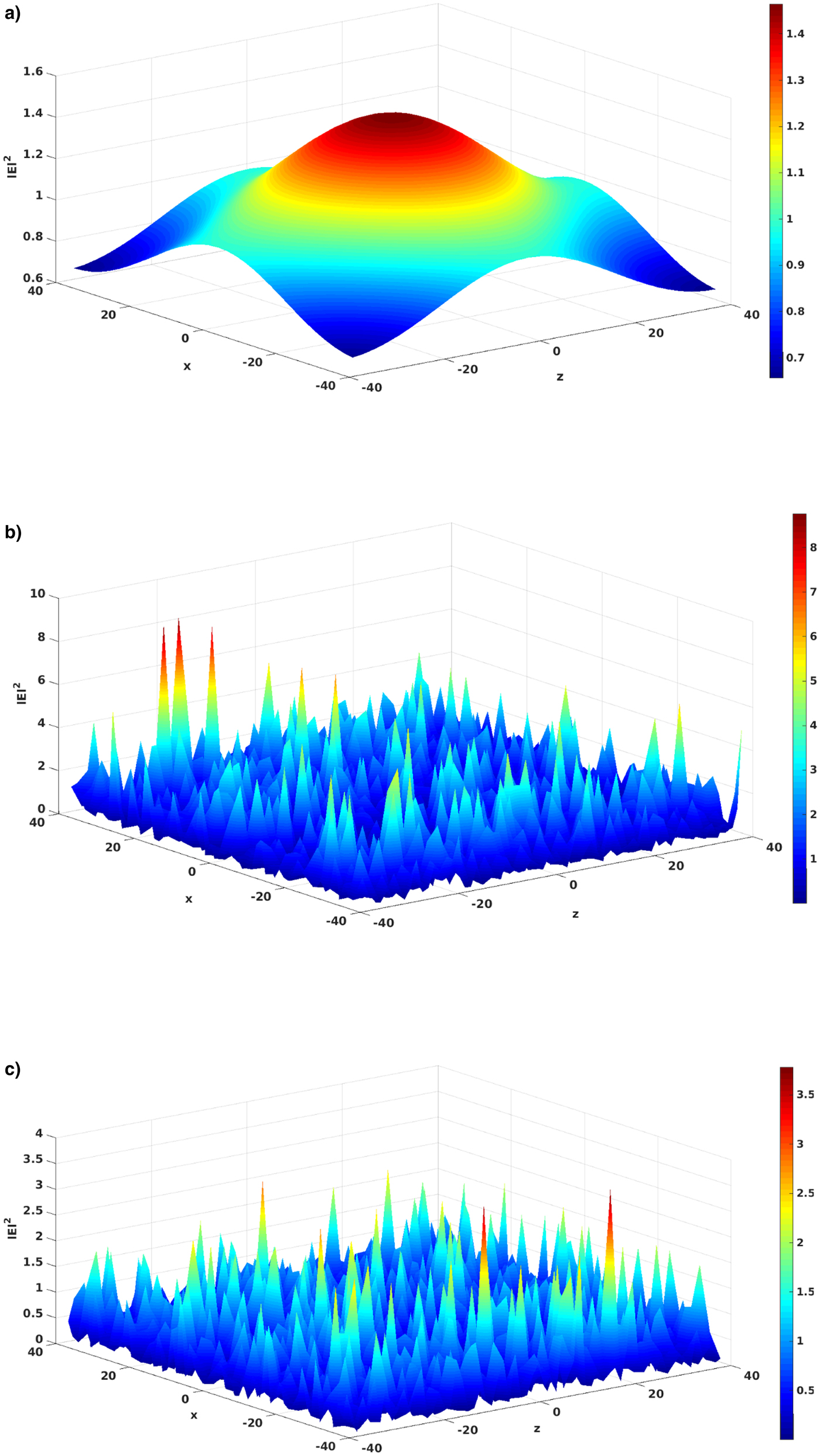
Fig. 1. Normalized intensity profile of the laser beam in the x-z plane at a distinct time (a) t ′ = 0, (b) t ′ = 8, and (c) t ′ = 16.
Electron plasma oscillations perturb the background electron density because the non-linear force arises from the laser pump. This causes the variation of density in the form of modes/harmonic and non-linear coupling between plasma oscillation and laser pump. The density variation or non-linear coupling causes filamentation of laser pump that results in localized structures. Figure 1a shows the commencement of the localized structure formation that progressively grows into a complex localized structure as shown in Figure 1b, 1c. Figure 2 depicts the variation of electron density in the x-z plane at a normalized time, t ′ = 5. It shows the density depletion in some regions of the x-z plane. The density cavity formations are observed at a distinct time related to the electric field coherent structures. Figure 3 represents the frequency spectrum of the electron plasma oscillations. In this figure, one can observe the excitation of plasma oscillation of THz frequency, appearing due to the density oscillations generated at k x = αx, 2αx, 3αx upto 64αx and the oscillations' peak lies in the THz frequency region. In laser–plasma interaction, the generation of an acoustic wave in the THz region has been experimentally reported by Adak et al. (Reference Adak, Robinson, Singh, Chatterjee, Lad, Pasley and Kumar2015). Figure 4a, 4b shows the normalized density mode | n| variation with k x (when k z = 0) at a distinct time. With time, the higher order density modes are generated. The non-linear force due to the laser beam, which is given in R.H.S. of eqn. (12), is responsible for the generation of harmonic in the density (Hussain et al., Reference Hussain, Sharma, Singh, Uma and Sharma2017). When k z = αz = 0, at any time we may write Eqs. (13a) and (13b) as follows
 $$n^{\prime}\lpar {x^{\prime},0} \rpar = -\lpar {1 + {\rm \beta} \cos \lpar {{\rm \alpha}_xx^{\prime}} \rpar } \rpar ^2 = -\lpar {1 + {\rm \beta}^2{\cos}^2\lpar {{\rm \alpha}_xx^{\prime}} \rpar + 2{\rm \beta} \cos \lpar {{\rm \alpha}_xx^{\prime}} \rpar } \rpar $$
$$n^{\prime}\lpar {x^{\prime},0} \rpar = -\lpar {1 + {\rm \beta} \cos \lpar {{\rm \alpha}_xx^{\prime}} \rpar } \rpar ^2 = -\lpar {1 + {\rm \beta}^2{\cos}^2\lpar {{\rm \alpha}_xx^{\prime}} \rpar + 2{\rm \beta} \cos \lpar {{\rm \alpha}_xx^{\prime}} \rpar } \rpar $$
Fig. 2. Plot of the normalized electron density in the x-z plane at a normalized time, t ′ = 5.

Fig. 3. Plot of the normalized frequency spectrum of the plasma density oscillations.
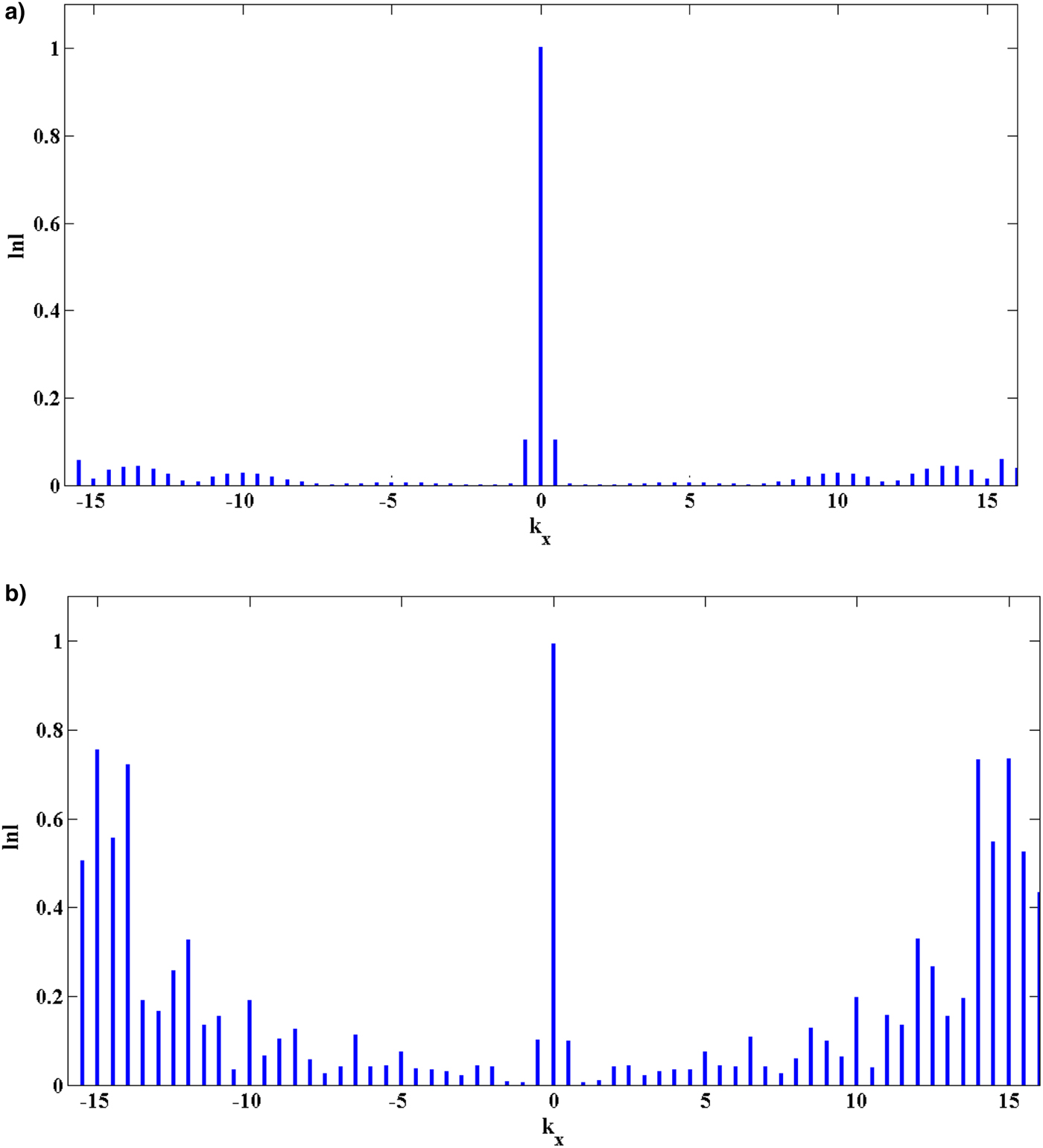
Fig. 4. Variation of the normalized electron density | n|versus k x (at fixed k z) for a normalized time (a) t ′ = 3 and (b) t ′ = 23.
Equation (15) signifies the generation of density harmonics at αx and 2αx. Using Eqs. (14) and (15), the R.H.S. term n ′A ′ of Eq. (11) can be expressed as
Equation (15) shows the generation of density harmonics corresponding to αx and 2αx. Combining Eqs. (14), (15), and (11) one can observe the generation of density harmonics corresponding to αx, 2αx, and 3αx as given in Eq. (16).
Transient self-focusing: a semi-analytical approach
In this section, a semi-analytical approach is discussed using the results acquired from the simulation to describe the role of the non-linear progression of the laser beam as the localized structure and varying number density (Sharma et al., Reference Sharma, Hussain and Gaur2015; Hussain et al., Reference Hussain, Sharma, Singh, Uma and Sharma2017). For a wave having rapid phase variation, the wave equation in the WKB approximation by neglecting the time variation can be written as
where n n is the normalizing electron density and the time-dependent term (n e/n n) can be obtained from simulation results. The time-dependent term is further expanded to incorporate its dependency in Eq. (17).
 $$\displaystyle{{n_{\rm e}} \over {n_{\rm n}}} = N + \sum\limits_{\,j = 1}^{64} {n_j\lpar {\cos \lpar {\,j{\rm \alpha}_x{x}^{\prime}} \rpar } \rpar } \,\, = N + \sum\limits_{\,j = 1}^{64} {n_j\left( {1-\displaystyle{{\,j^2{{x}^{\prime}}^2{\rm \alpha}_x^2} \over 2} + \ldots} \right)} $$
$$\displaystyle{{n_{\rm e}} \over {n_{\rm n}}} = N + \sum\limits_{\,j = 1}^{64} {n_j\lpar {\cos \lpar {\,j{\rm \alpha}_x{x}^{\prime}} \rpar } \rpar } \,\, = N + \sum\limits_{\,j = 1}^{64} {n_j\left( {1-\displaystyle{{\,j^2{{x}^{\prime}}^2{\rm \alpha}_x^2} \over 2} + \ldots} \right)} $$Here, N and n j are the Plasmon number and the number density of harmonics obtained through simulation for j = 1 to 64. One may write the solution of Eq. (17) as follows (Akhmanov et al., Reference Akhmanov, Sukhorukov and Khokhlov1968).
Using the Eqs. (18) and (19) in Eq. (17), and thereafter equating the real and imaginary parts we get Eqs. (20) and (21)
 $$-2k_0^2 A_0\displaystyle{{\partial S} \over {\partial z}} + \displaystyle{{\partial ^2A_0} \over {\partial x^2}}-k_0^2 A_0\left( {\displaystyle{{\partial S} \over {\partial x}}} \right)^2-\displaystyle{{k_0^2} \over {{\rm \xi} \,{\rm \gamma}}} A_0\left( {N + \sum\limits_{\,j = 1}^{64} {n_j\left( {1-\displaystyle{{\,j^2{{x}^{\prime}}^2{\rm \alpha}_x^2} \over 2} + \ldots} \right)}} \right) = 0$$
$$-2k_0^2 A_0\displaystyle{{\partial S} \over {\partial z}} + \displaystyle{{\partial ^2A_0} \over {\partial x^2}}-k_0^2 A_0\left( {\displaystyle{{\partial S} \over {\partial x}}} \right)^2-\displaystyle{{k_0^2} \over {{\rm \xi} \,{\rm \gamma}}} A_0\left( {N + \sum\limits_{\,j = 1}^{64} {n_j\left( {1-\displaystyle{{\,j^2{{x}^{\prime}}^2{\rm \alpha}_x^2} \over 2} + \ldots} \right)}} \right) = 0$$and
Introducing an eikonal and initially Gaussian beam of initial beam width r 0,
and
here, E 00 is the initial amplitude of the laser beam. On substituting Eqs. (22) and (23) in Eq. (20) and equating the x 2 coefficients; in the paraxial ray approximation, the beam width parameter f is given by
 $$\displaystyle{{d^2f} \over {d{\rm \xi} ^2}} = \displaystyle{1 \over {\,f^3}}-\displaystyle{1 \over {{\rm \xi} {\rm \gamma}}} \left( {\displaystyle{{r_0^2 {\rm \omega}_0^2} \over {c^2}}} \right)\displaystyle{1 \over {\,f^2}}\left( {\displaystyle{{E_{00}} \over {E_{\rm n}}}} \right)^2-\displaystyle{1 \over {{\rm \xi} {\rm \gamma}}} \left( {\displaystyle{{r_0^4 {\rm \omega}_0^2} \over {c^2}}} \right)\displaystyle{{\,f\,{\rm \alpha} _x^2} \over 2}\sum\limits_{\,j = 1}^{64} {n_jj^2} $$
$$\displaystyle{{d^2f} \over {d{\rm \xi} ^2}} = \displaystyle{1 \over {\,f^3}}-\displaystyle{1 \over {{\rm \xi} {\rm \gamma}}} \left( {\displaystyle{{r_0^2 {\rm \omega}_0^2} \over {c^2}}} \right)\displaystyle{1 \over {\,f^2}}\left( {\displaystyle{{E_{00}} \over {E_{\rm n}}}} \right)^2-\displaystyle{1 \over {{\rm \xi} {\rm \gamma}}} \left( {\displaystyle{{r_0^4 {\rm \omega}_0^2} \over {c^2}}} \right)\displaystyle{{\,f\,{\rm \alpha} _x^2} \over 2}\sum\limits_{\,j = 1}^{64} {n_jj^2} $$where ![]() ${\rm \xi} \lpar { = \lpar {c\,z/r_0^2 {\rm \omega}_0} \rpar } \rpar $ is the dimensionless distance of propagation and r 0( = 10 μm) is the transverse scale size of the wave. Runge Kutta method (fourth order) has been adopted to solve Eq. (24) with the initial boundary conditions
${\rm \xi} \lpar { = \lpar {c\,z/r_0^2 {\rm \omega}_0} \rpar } \rpar $ is the dimensionless distance of propagation and r 0( = 10 μm) is the transverse scale size of the wave. Runge Kutta method (fourth order) has been adopted to solve Eq. (24) with the initial boundary conditions![]() $f = 1,\;d{\kern 1pt} f/d {\rm \xi} = 0$ at ξ = 0. The wave can propagate without divergence and convergence when the diffraction term [due to the first part of the R.H.S. of Eq. (24)] balances the non-linear part term [due to the second and third part of the R.H.S. of Eq. (24)]. It is the third term of Eq. (24) that accommodates the transient progression as the magnitude of spectral modes varies with time, thus the transient progression effect of laser pulse occurs. When the laser travels in the plasma, the non-linearity arises in the beam and it suffers self-focusing. With time, the decrease of non-linearity becomes more prominent due to the dominance of natural diffraction and causes the beam defocusing. This phenomenon leads to the competition among the diverging and the converging term (due to the relativistic ponderomotive non-linearity and density oscillations contribution) and leads to the oscillatory self-focusing of the beam. Figure 5a, 5b shows the laser beam localization for two different times, one can notice from the figure that in early time when the impact of the density oscillations via non-linearity is trivial initially then there is no beam focusing. However, the contribution from the density oscillations turns out to be important and leads into a laser beam focusing in a later time.
$f = 1,\;d{\kern 1pt} f/d {\rm \xi} = 0$ at ξ = 0. The wave can propagate without divergence and convergence when the diffraction term [due to the first part of the R.H.S. of Eq. (24)] balances the non-linear part term [due to the second and third part of the R.H.S. of Eq. (24)]. It is the third term of Eq. (24) that accommodates the transient progression as the magnitude of spectral modes varies with time, thus the transient progression effect of laser pulse occurs. When the laser travels in the plasma, the non-linearity arises in the beam and it suffers self-focusing. With time, the decrease of non-linearity becomes more prominent due to the dominance of natural diffraction and causes the beam defocusing. This phenomenon leads to the competition among the diverging and the converging term (due to the relativistic ponderomotive non-linearity and density oscillations contribution) and leads to the oscillatory self-focusing of the beam. Figure 5a, 5b shows the laser beam localization for two different times, one can notice from the figure that in early time when the impact of the density oscillations via non-linearity is trivial initially then there is no beam focusing. However, the contribution from the density oscillations turns out to be important and leads into a laser beam focusing in a later time.
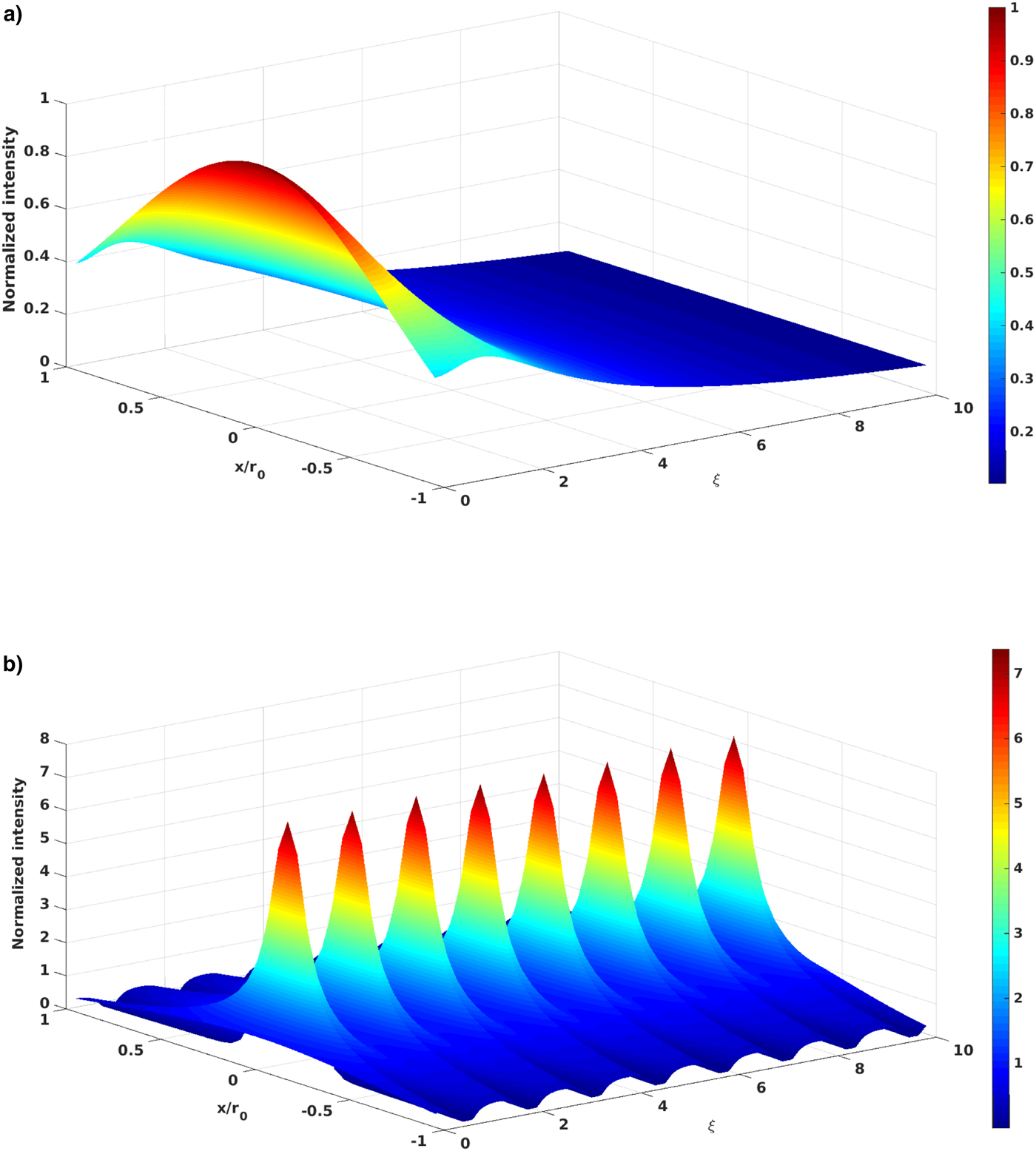
Fig. 5. Normalized intensity profile of the laser beam in the paraxial regime obtained by a semi-analytical model in the x-z plane at a distinct time (a) t ′ = 2 and (b) t ′ = 23.
Conclusion
The transient evolution of laser beam has been investigated in the occurrence of relativistic ponderomotive non-linearity in under-dense plasma. The numerical simulation has been accomplished for coupled equations of laser pump and plasma oscillation without assuming the quasistatic approximation. We observed the laser light getting localized and these localized structures become more complex with time evolution. The results also show that the electron plasma oscillation's frequency spectra have peaks in the THz region. In addition to the filamentary density depletions, a substantial density cavity has also been observed. Periodic perturbation produced the density harmonics which affects the localization of the laser beam. A semi-analytical model has been developed using the computational results to study the time-varying self-focusing phenomenon of the laser beam. The semi-analytical model predicts that time-varying self-focusing of the laser beam depends on the values of density harmonics. The present model is applicable in experimental and theoretical studies involving transient localization of the laser beam in plasma.
Author ORCIDs
Narender Kumar, https://orcid.org/0000-0003-4330-4015.
Acknowledgments
This work was supported by the Department of Science and Technology (DST), India.



